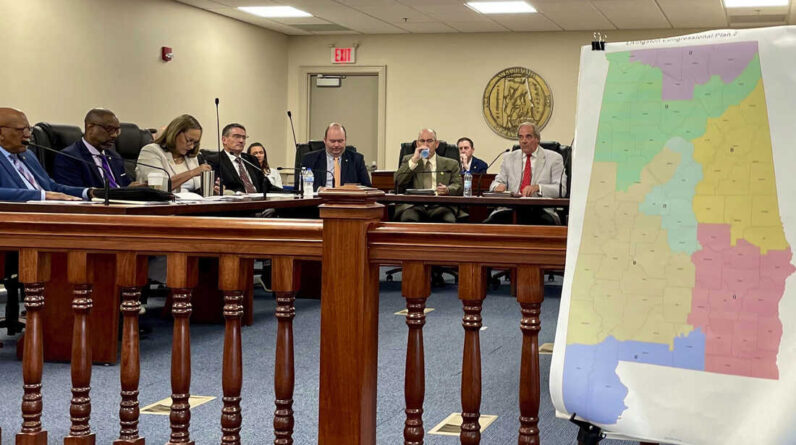
An Alabama Senate committee discusses a proposal to draw new congressional district lines Thursday in Montgomery, Alabama. Kim Chandler/AP hide caption
toggle subtitle
Kim Chandler/AP

An Alabama Senate committee discusses a proposal to draw new congressional district lines Thursday in Montgomery, Ala.
Kim Chandler/AP
MONTGOMERY, Ala. (AP) – Alabama lawmakers on Friday refused to create a second majority-black congressional district, a move that could defy a recent U.S. Supreme Court order to give minority voters more voice in elections and trigger a new battle over the state’s political map.
The legislation now goes to Alabama Governor Kay Ivey, who is expected to sign it.
Instead, lawmakers in the Republican-dominated House and Senate approved a plan that would increase the percentage of black voters from 31 percent to 40 percent in the state’s 2nd District. A conference committee proposed the map as a compromise between plans that had percentages of 42 percent and 38 percent, respectively, for the southeast Alabama district.
Republicans argued that the proposal complies with a court order to create a district where black voters could influence the outcome of congressional elections. But black lawmakers said the new map invoked the state’s Jim Crow history of treating black voters unfairly and ignored a directive from a three-judge court to create a majority-black second district or “something pretty close” so that black voters “have an opportunity to elect a representative of their choice.”
“There is no chance for anyone other than a white Republican to win this district. They will never, ever elect a Democrat. They will not elect a black person. They will not elect a minority,” said Sen. Rodger Smitherman, D-Birmingham.

Republicans have been reluctant to create a Democratic-leaning district and are betting big that the panel will accept their proposal or that the state will prevail in a second round of appeals. Republicans argued the map complies with the court’s directive and draws compact districts that meet redistricting guidelines.
“We were also careful not to manipulate our maps racially,” said House Speaker Pro Tempore Chris Pringle.
The debate in Alabama is being watched closely across the country and could be reflected in fights in Louisiana, Georgia, Texas and other states.
The three-judge panel ruled in 2022 that the current legislative map likely violates the federal Voting Rights Act and said any map would have to include two districts where “black voters comprise a majority of voting age” or something similar. The Supreme Court upheld this decision.
Now that the plan has passed, the fight will quickly return to federal court. The plaintiffs who won the Supreme Court case have vowed to fight the proposal if it passes.
“Let’s be clear: The Alabama Legislature believes it is above the law. What we’re dealing with is a group of lawmakers who blatantly ignore not only the Voting Rights Act, but a US Supreme Court decision and a three-judge district court order,” plaintiffs in the case said in a statement Friday.

Passage of the plan is almost certain to trigger a new legal battle over whether Alabama’s congressional districts comply with federal law and give black voters and candidates a fair chance in a political landscape dominated by white Republicans. Smitherman said Republicans appear to be waiting for one of the justices to “hit the script” and rule for the state in the runoff.
Black lawmakers in Alabama say it’s crucial that their constituents have a better chance to choose their options.
“I have people in my district who say their vote doesn’t count, and I understand why they say that,” Rep. Thomas Jackson, D-Thomasville, said during the debate Friday. “The person they want to elect can never be elected because they are in the minority all the time.”
An analysis by The Associated Press, using redistricting software, shows the 2nd District proposed Friday has voted overwhelmingly Republican in recent state elections. Donald Trump won the district by nearly 10 percentage points in his 2020 re-election bid.
Experts have said the GOP proposals fall short of what the Supreme Court said last month was required.
“They’ve pretended like the court didn’t say what it said,” said Kareem Crayton, senior director of voting and representation at New York University’s Brennan Center for Justice. The Brennan Center filed a brief in support of the plaintiffs before the Supreme Court.
Those who study redistricting say it’s simply not enough, given the way Alabama voters split along racial lines. Whites mostly vote for Republicans and blacks mostly vote for Democrats. This divide is also reflected among elected officials. There are 33 black lawmakers in Alabama’s 140-seat legislature. All but one are Democrats.
Republican lawmakers hope to show the issues of compact districts and unified communities in court. They hope a second round of litigation, or even another trip to the Supreme Court, will allow them to avoid creating a map that gives a second of Alabama’s seven congressional districts to a Democrat.
Crayton is skeptical that the high court will immediately reverse its decision, saying federal courts discount compactness and preserve communities in redistricting.
“You can’t take a stand on matters that are rooted in federal law,” Crayton said, calling those arguments “silly.”
[ad_2]
Source link





